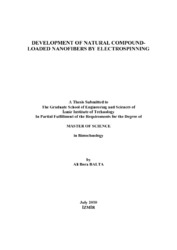Please use this identifier to cite or link to this item:
https://hdl.handle.net/11147/3750Full metadata record
| DC Field | Value | Language |
|---|---|---|
| dc.contributor.advisor | Bayraktar, Oğuz | en |
| dc.contributor.author | Balta, Ali Bora | - |
| dc.date.accessioned | 2014-07-22T13:52:17Z | - |
| dc.date.available | 2014-07-22T13:52:17Z | - |
| dc.date.issued | 2010 | en |
| dc.identifier.uri | http://hdl.handle.net/11147/3750 | - |
| dc.description | Thesis (Master)--Izmir Institute of Technology, Biotechnology, Izmir, 2010 | en |
| dc.description | Includes bibliographical references (leaves: 92-104) | en |
| dc.description | Text in English; Abstract: Turkish and English | en |
| dc.description | xiii, 137 leaves | en |
| dc.description.abstract | In this study, the crude silk which is obtained from silkworm was turned into a silk solution after a serial procedure. Then, regenerated silk (foam) was obtained. The regenerated silk was dissolved in formic acid and polymer solution was prepared. After, nanofibers were produced by electrospinning. On the other hand, the content and antimicrobial activities of some plants were analyzed. Then all three forms of silk was absorbed with the olive leaf extract and extract desorption tests were done. As the first step of the study, the analyses of extracts which were obtained from four different plants were done. For this, total phenolic content and antioxidant capacity were found. In addition, minimum inhibition concentration (MIC) test and disc diffusion test were made for all extracts to Escherichia coli, Staphylococcus epidermidis, Staphylococcus aureus, Bacillus subtilis, Pseudomonas aeruginosa bacteria and Candida albicans fungi in order to determine their antimicrobial activity. While producing nanofibers from silk polymer with electrospinning method, different parameters such as concentration, voltage and distance were examined. Morphological characterization of nanofibers was done by scanning electron microscope (SEM). According to the results, the nanofiber with an optimum value which has a suitable diameter and structure was selected. With this nanofiber, the absorption and desorption tests of natural compound were made. The results were obtained by High pressure liquid chromatography (HPLC). Same adsorption and desorption tests were done also with the microfiber silk and regenerated silk (foam). As a result, it was shown by the controlled experiments that nanofibers were better for adsorption and desorption of natural compound when compared to microfiber silk and regenerated silk. In conclusion, nano-sized silk fibroin structures can be adsorbed with natural compounds in order to gain functionality. Using this kind of biofunctional products as medical textile and wound dressing material will be more advantageous when compared to current wound dressing materials. | en |
| dc.language.iso | en | en_US |
| dc.publisher | Izmir Institute of Technology | en |
| dc.rights | info:eu-repo/semantics/openAccess | en_US |
| dc.subject.lcsh | Textile--Fibers--Testing--Laboratory manuals | en |
| dc.subject.lcsh | Silk--Testing | en |
| dc.subject.lcsh | Nanofibers | en |
| dc.subject.lcsh | Electrospinning | en |
| dc.title | Development of natural compound-loaded nanofibers by electrospinning | en_US |
| dc.type | Master Thesis | en_US |
| dc.institutionauthor | Balta, Ali Bora | - |
| dc.department | Thesis (Master)--İzmir Institute of Technology, Bioengineering | en_US |
| dc.relation.publicationcategory | Tez | en_US |
| item.languageiso639-1 | en | - |
| item.fulltext | With Fulltext | - |
| item.openairecristype | http://purl.org/coar/resource_type/c_18cf | - |
| item.openairetype | Master Thesis | - |
| item.grantfulltext | open | - |
| item.cerifentitytype | Publications | - |
| Appears in Collections: | Master Degree / Yüksek Lisans Tezleri | |
Files in This Item:
| File | Description | Size | Format | |
|---|---|---|---|---|
| T000216.pdf | MasterThesis | 5.61 MB | Adobe PDF |  View/Open |
CORE Recommender
Page view(s)
144
checked on Jul 22, 2024
Download(s)
400
checked on Jul 22, 2024
Google ScholarTM
Check
Items in GCRIS Repository are protected by copyright, with all rights reserved, unless otherwise indicated.